How Do You Know What Goods Are Groupon Marketplace
The idea of an online marketplace has been a popular option for some time. It offers greater convenience to people who want to purchase products or services online. The internet has made things easier for anybody, and marketplaces let customers to find their desired items and have them delivered to their homes at affordable rates.
With a couple of clicks, yous manage to find great deals online and have any blazon of product, electronic gadgets, or furniture delivered to your doorstep. Anyone aiming at selling their products understands the benefits of a stiff online presence and wants to build a marketplace app, simply creating a successful app requires considerable resources and a lot of knowledge. If you take been searching for information online on how to build a marketplace app, y'all accept come to the right place.
Below, we discuss the following questions:
- What the main market characteristics are
- What differentiate marketplaces from online stores
- How you can build a marketplace app from scratch.
What is a Marketplace Platform?
Unlike online stores, the online marketplace platform offers independent sellers the opportunity to listing their products and services.
There are various types of marketplace platforms of different sizes marked with lots of options ranging from products that sellers offer to a choice of marketing strategy. The technology and pricing will as well exist different depending on the location and purpose of the marketplace.
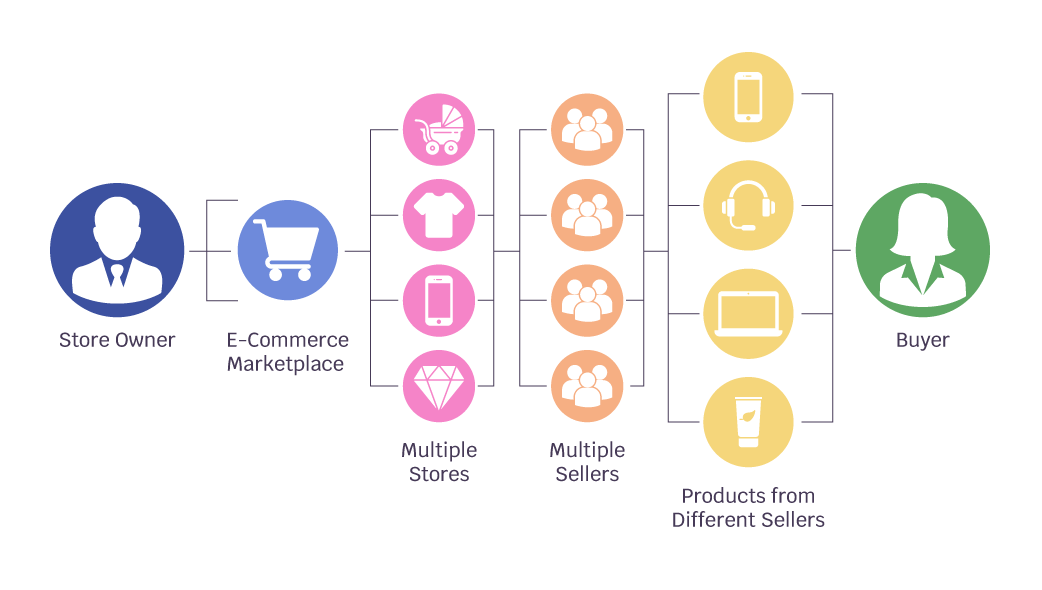
The of import factor to regard is to realize the function of the marketplace as a mediator. Marketplaces bridge the gap betwixt sellers and buyers. Hence, the purpose of a marketplace is to provide effective cooperation while connecting buyers and sellers.
Online stores only offering their own services and appurtenances and control all aspects including the products, prices, commitment, and payment. Wondering how to build a marketplace platform, you should remember that a market offers a platform for listing services and a payment system. These marketplaces can be used for exchanging goods or to merchandise since they include everything from online services like coupons and apps to physical objects like electronic devices, furniture, or vesture.
Why Should You Build A Market App?
Before wondering how to build a marketplace, you need to answer the question of why you need it. Marketplace apps are the hottest trend right now, especially with the dominance of marketplace app examples like Amazon, Etsy, eBay, Airbnb, Uber, and Groupon. All these companies have gone on to become billion-dollar businesses that achieved unparalleled growth. This has plainly shed lite on different marketing concepts like B2B, B2C, and C2C. A successful market will be based on scalability, execution, functioning, and pattern.
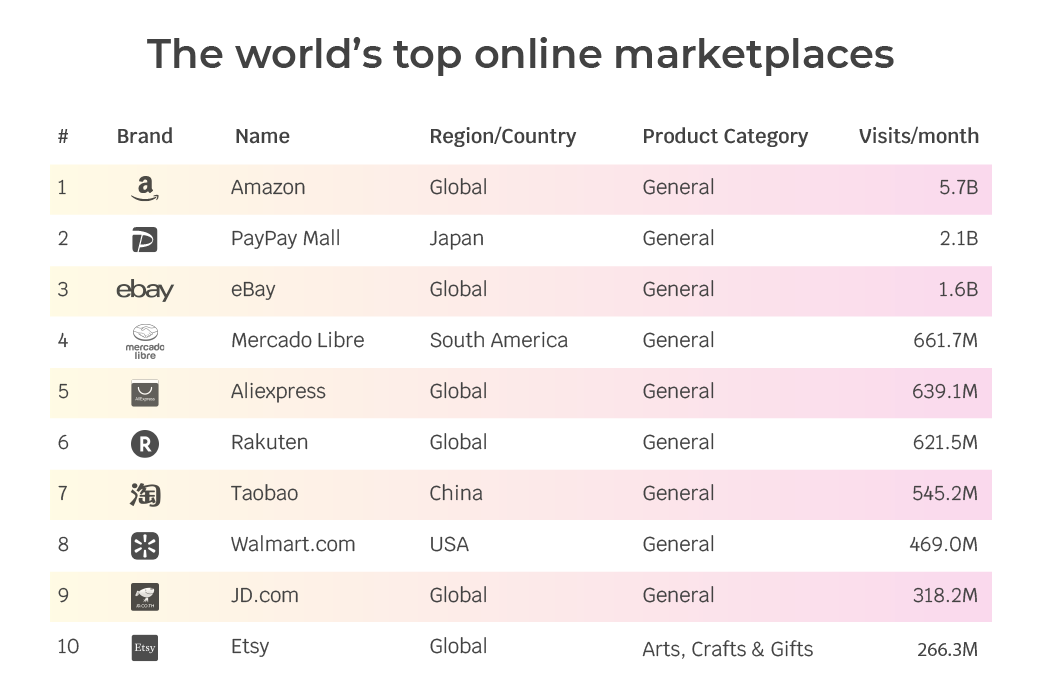
Mobile commerce has get the preferred method for customers shopping online, as they can hands admission different products and services online. E-commerce sales in the United States have gone through the roof later on the emergence of mobile commerce companies, with revenues generating more than than $200 billion last twelvemonth. The popularity of mobile shopping has meant that more than retailers in the United states have started to invest in marketplace apps.
About global businesses that are online have moved their activities to mobile platforms, as smartphones and tablets take immune them to interact with clients in real-time. The market for mobile commerce applications is expected to attain exponential growth, as eBay's mobile awarding shows. It has been downloaded more than 51 one thousand thousand times, has been localized in ten languages, and is bachelor in over 195 countries worldwide!
Take a look at online shopping platform nosotros've recently helped to create
Nomenclature: The Master Types of Marketplaces
Before y'all build your web or mobile market place app it is important that you determine what type of market you want, since there are various versions of marketplaces.
They tin be divided into different categories co-ordinate to customer type, selling model, market sectors, etc.
Nomenclature of online marketplaces | |
|---|---|
| Past target audience |
|
| By focus |
|
| By management approach |
|
| By products |
|
| By interaction |
|
By target audience
Business-to-Business (B2B) marketplaces
The business-to-business model enables businesses to use a market place for bringing more customers to sellers, aggrandize the area of achieve and perform the office of product distribution at all-time.
Business organisation-to-Client (B2C) marketplaces
Opting for this model means products and services are sold directly from businesses to customers. The majority of B2C marketplaces (AliExpress is one of the virtually prominent examples of this kind) innovate one-stop-store solutions with offer various appurtenances. Vendors' propositions range from footwear to electronics.
Peer-to-Peer (P2P) marketplaces
A peer-to-peer (P2P) also known equally a client-to-customer (C2C) market place is best presented by Uber and Etsy: in this model, the marketplace lets customers share products and services and manage selling.
By focus
Vertical market
In a vertical model, consumers are interested in the certain business niche. Information technology reduces the number of users but enables highly efficient promotion by targeting the audience without fail.
Horizontal market
With this platform, consumers go access to different types of goods and services of certain characteristics.
By products
Product marketplaces
The near common type of marketplace featuring products offered by sellers with Amazon and eBay equally the key players.
Check our case written report: Online marketplace, created by CodeIT team from scratch
Service marketplaces
Aimed at those in demand for services (repairing, transportation, household, car and flat rentals, beauty/medical services, and It services) offered on Uber, Airbnb, Upwork, and TaskRabbit.
Project marketplaces
These marketplaces arrange funds through crowdfunding for startup projects. Examples: Kickstarter, Indiegogo, and Fundable.
Hybrid marketplaces
As the proper name suggests, they normally offering both services and products (for instance, OLX, Craigslist, Oodle).
By interaction
Online commerce
Online commerce platforms (for example, Google Shopping) conquered markets through Information Interchange that requires suppliers and customers to set up a dedicated data link to the marketplaces where customers look to purchase the advertised production.
Online-to-offline
Online-to-offline commerce platforms (O2O) spot customers in the online space. Taking this arroyo implies bringing online customers to brick and mortar locations by creating a seamless digital experience.
GOT AN Thought FOR A Market APP? Allow'Southward Talk over!
How Practice You lot Build One?
Finally, nosotros come to the question of how to build a market place website or app. The secret of marketplace app development lies in a lot of cloth gathering and investigation. Information technology is imperative to evaluate all risks before starting any project, and this doesn't involve any perfect code to create a web or mobile marketplace app. Grasping what the procedure demands are integral to creating a successful marketplace application, and that is exactly what we are going to discuss below.
How to build a market correctly? You need to take the following steps:
1. Identifying User Activity
2. Setting Up the Structure
3. Choosing a monetization model
iv. Marketplace Application End User Identification
5. Setting Up the Mandatory Features
6. Prototyping and Project documentation
7. UI/UX Design
8. The option of a tech stack
ix. Scaling and Expansion
10. Money and Time Estimation
The costs associated with marketplace app evolution are mainly dependent on the features you want in the app. However, if you lot desire to build a mobile app like Amazon or eBay, it will require a lot of time, effort, and resources. The expert news is that you tin practice it if you go well-nigh information technology in the correct manner. And then, here is how you should go well-nigh creating your own marketplace app:
The Importance of Identifying User Action
The first pace towards edifice a successful online marketplace app is to understand the user activeness that will take place in the marketplace. This will determine the type of market you lot are edifice, how it volition operate, and what it volition offering to users. Keeping user activity in mind while you build a market website or app is crucial since it allows you to set up specific targets. So, let's check out the diverse eCommerce marketplaces and what type of user activity they get:
Product marketplaces mainly target buyers and sellers, with the sellers listing their products and the buyers purchasing them.
Service marketplaces attract freelancers, vendors, and professionals who are willing to provide their services, and employers looking for experts to perform tasks.
More of our expertise: Australia's leading peer-to-peer platform that allows independent care workers to connect directly with aged community
Project marketplaces target backers and owners who are investing coin in a project or raising money for the projection, in the hopes of getting a profit in the hereafter.
Hybrid marketplaces target various types of users, since they offer a mix of everything, and therefore users are mainly guests, employers, vendors, buyers, and sellers.
Setting Upwardly the Structure
One of the most important steps in building a market app is to prepare a proper structure for your app. The construction of your web or mobile marketplace app is preconditioned by dissimilar aspects and is linked with your overall business organisation strategy. Therefore, when laying downward the foundations of a marketplace, yous must prepare clear concern goals with a proper strategy.
So, how do you lot get about setting up the structure? You tin can outset by answering the following questions:
Who will be using the marketplace?
It is important to know your potential users and what they wait so that you can ameliorate the UI of the platform. The blazon of user activity on the market will determine the functionality of the market place and what it offers users.
What services will be offered?
This is one of the most of import questions to consider because the answer volition govern the entire structure of the market place. For example, Airbnb and eBay are both online auction and adaptation rental services market place, merely they are completely dissimilar in terms of looks.
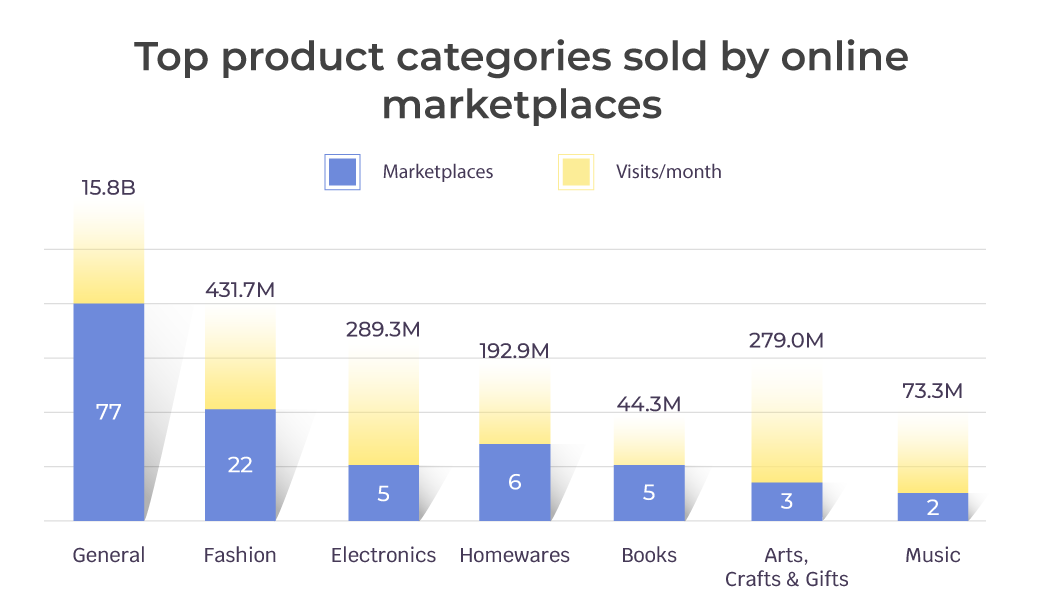
How will tasks exist carried out?
The answer to this question volition help you decide what APIs, plugins, and integrations to implement in the development process of your marketplace.
Building a marketplace app isn't easy past whatever stretch of the imagination, and the merely way it will work is when you have a deep agreement of your business and have experienced developers who consider every aspect and employ cut-edge solutions that allow exemplary operation of your market app.
Choosing a monetization model
There are five models to choose from:
- Committee
- Subscription fee
- Listing Fee
- Featured listings
- Advertizement.
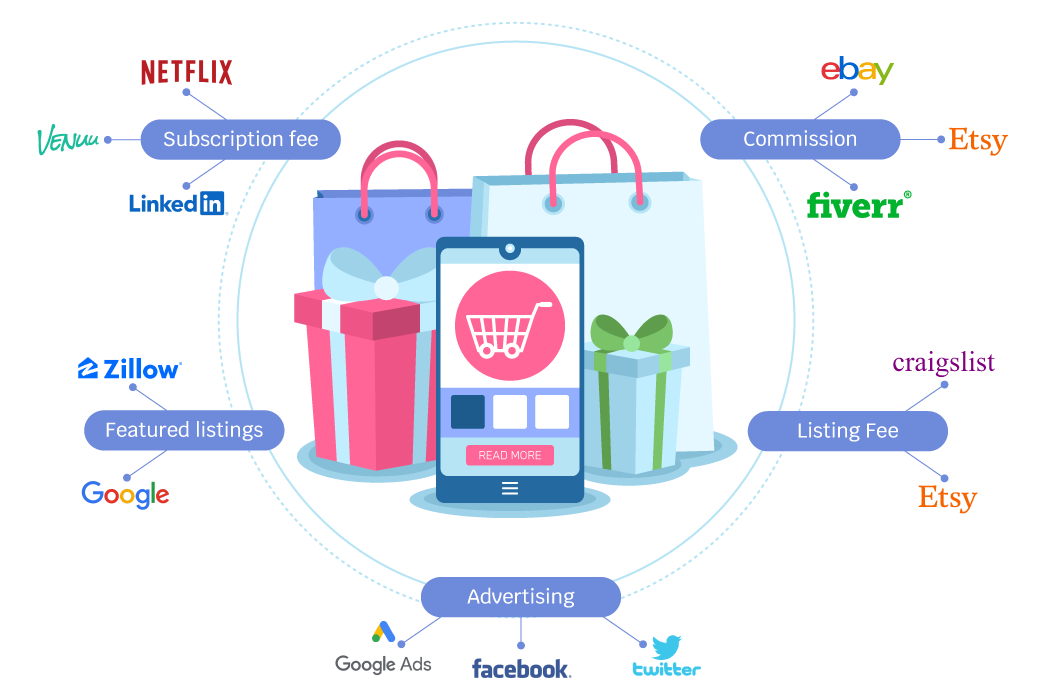
Charging commissions off each transaction registered on the platform is one of the most widely used monetization models practical by such giants as Rakuten, eBay, Etsy, Airbnb
Subscription fee implies that users pay money for membership that ensures access to the service. Fees can exist charged monthly or annually. The apps that employ this kind of monetizing are Amazon Prime, Netflix, and Google Play Music.
This model is applied when marketplaces charge a fee from providers posting new listings. In this instance, providers go value based on the number of listings available on the site. An instance of this model tin exist found on Flippa.
Featured listings enable sellers to get more than visibility for their offerings. Providers take to pay to become featured on the homepage of the site or appear on the pinnacle in category search. This model is utilized past Gumtree, for case.
Advertising in the form of a paid promotion for sellers getting a identify at the top of the listing is very popular as the channel of the marketplace acquirement. Google Ads service is one of the well-known examples of the application of this model.
Marketplace Application End User
The marketplace apps functionalities differ past the end user they are designed for and showcase different usability that we discuss below.
Product/Service Provider App
The app is designed for vendors that want to go recognizable in their corresponding industries and reach customers easily. The app usually features a vendor business relationship and includes options that let vendors to manage products and orders, get instant notifications, and create reports.
Customer App
The well-nigh important for the customer is to view diverse products or services and be able to choose the best deal. It means that the app has to feature products and have info on promotions. With a buyer account, customers expect to have options of social connect, clear products listings, quick checkouts, and support of multiple payment methods.
Ambassador App
Information technology is designed for mediators that take intendance of the operational function of transactions and get revenue from a fee charged for services.
Setting Upwards the Mandatory Features
Irrespective of the marketplace app blazon, the app requires the development of the post-obit panels :
- administration console
- seller (merchant) panel
- buyer console.
Assistants panel
This will enable control over the product inventory, procedures associated with payments, managing orders, clients database, and like settings like commissions for sellers, registering new users, categorizing items, managing reviews and ratings, and approving selected products. The administration panel is not essential for the customers and will be visible on the backend side.

The must-have features include:
- Real-time updates from a single dashboard
- User management solutions
- Options for charging a committee
- Analytics and Reports
- Stock visibility and management
- Client management
- Invoicing Solutions
- Itemizing past Category
- Tax management.
Seller/Merchant panel
 The must-take features for the seller panel include:
The must-take features for the seller panel include:
- Social Connect and Sign-up Login
- Display of vendor-specific shop URLs
- Order management solutions
- Stock management
- Offers, promotions, and discounts
- In-app chat system
- Transaction management
- Reports and analytics
The buyer panel

The mandatory features include:
- Registration/Potency
- Management of personal profile
- Customer support for connecting with sellers
- Listings
- Search engine for easy search
- Shopping cart
- Wishlist
- Reviews and testimonials
- Integrated payment functionality
- Tracking of customer order
As a side note, it should be stated that you tin combine seller and buyer roles within an application or create ii divide apps. Just for administrators, a split web application, preferably for desktop, is mandatory.
When information technology comes to online marketplaces and eCommerce information technology is tough to differentiate major features from your competitor's app, but you can offering add-ons and more value to attract users. These can include complimentary product listing for vendors, coin-dorsum guarantees, side by side 24-hour interval aircraft, costless aircraft, discounted pricing, and other benefits offered additionally. Naturally, the features of your marketplace app will vary depending on your business specifications and your goals.
Major development stages in-depth
You tin choose betwixt ii options when you lot decide to build a marketplace platform.
- Developing on top of existing market place software
- Create an online marketplace from scratch.
In the first case scenario, you lot get a ready-made solution that saves you lot time on launching the marketplace by taking shortcuts on wireframing, developing, or testing. But y'all must be ready that your competitors use the same template reducing your chance to stand out and accomplish customers faster. Besides, you will have to optimize the software operation on a regular ground.
When you determine to build your marketplace from scratch, yous should exist fix that it is more time-consuming because the process of development implies coding, quality testing, and fail-free launch. Merely in the long run, it's a more than reliable solution enabling you to get tailored functionality and integrations.
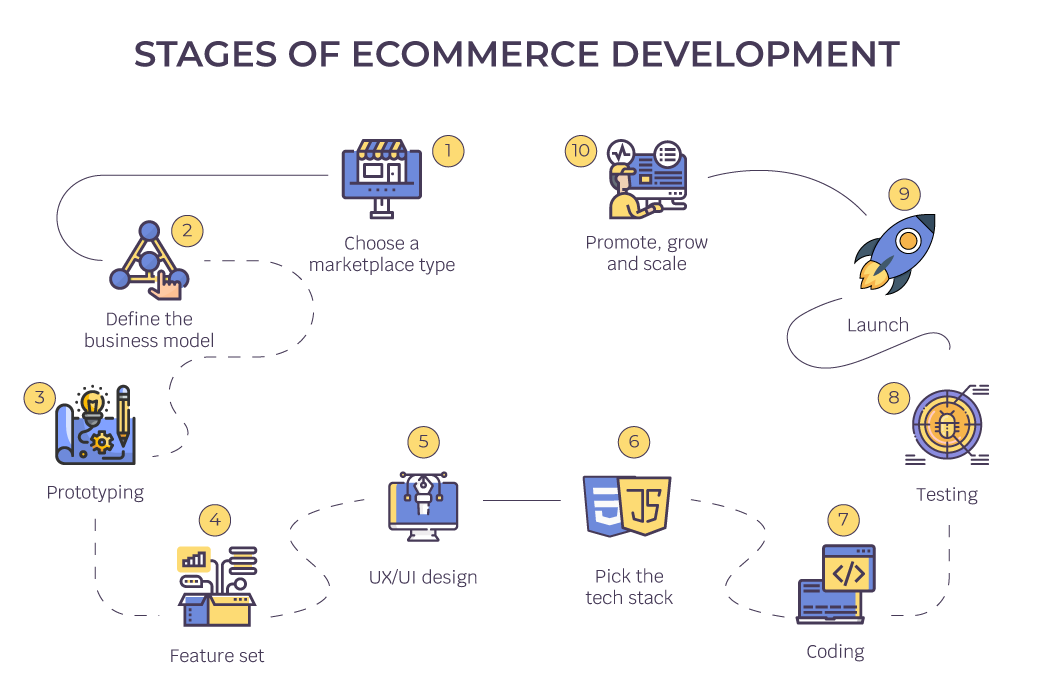
The process of custom market app development goes through the following stages:
Prototyping and Project documentation
At this stage, yous create a marketplace prototype so that information technology is piece of cake to understand how the end-user can employ the application, which requires a detailed description of interactions within the product functionality. This stage also includes checking the business potential of the idea and preparing the project documentation in the course of descriptions of software functionality and purpose. A technical specification includes stating the goals, writing down the specific guidelines, and descriptions from the end-user perspective.
UI/UX Design
While outlining the design, the team renders screens based on the stated goals, divers target audition, and approved functionality.
As a rule, there are several styles in piece of work at this stage. When the design is confirmed, the screens are designed to comply with the canonical concept.
Circuitous designs get-go with a minimum viable production (MVP) introducing the first version of the application. At this stage, the information on bugs is gathered and revision based on feedback is provided for further functioning of debugging and improving the pattern of the product.
The choice of a tech stack
The technologies and tools utilized in development are as listed beneath:
Programming languages: Coffee, PHP, and Python.
Mobile evolution: Android - Java, iOS - Swift, cross-platform - React Native
Front-finish: Angular, ReactJS, HTML5, CSS
Back-end: Node.js
Payments: Stripe, Braintree, and PayPal
Recommendations: Machine learning algorithms
Analytics: Google Analytics
Marketing Automation: HubSpot, MailChimp (for east-mails)
Infrastructure: Amazon Web Services
Databases: PostgreSQL, MySQL, MongoDB.
The team engaged in creating a marketplace app for Android and iOS include a Project manager, Backend developer, UI/UX designer, Android, and iOS developers, and QA engineer.
Scaling and Expansion
Once you launched your product and feel confident that your marketplace app has garnered plenty attention and is doing well against your competition, you should movement towards scaling and expanding. This can be done by:
Targeting multiple platforms
Release your products on the most popular and accessible platforms, so that users on various mobile platforms tin can easily admission and use your marketplace app.
Enhance functionality
You can also revamp or improve the functionality of your app by introducing new features that provide users with more luxury and more engaging experiences. You should collaborate with users to learn well-nigh their needs, then yous tin develop innovative features they want.
Start marketing for growth
At this phase, yous need to have a portrait of your potential suppliers and buyers to place the best channels of attracting your consumers.
You can practise it by yourself or with the assistance of marketing professionals. In the offset case you need:
- Go insights on your audience
- Analyze keywords that your prospective customers employ in regards to your niche
Now you are prepare to connect with the suppliers and negotiate the terms of your service.
Upon reaching an agreement, y'all brainstorm to attract buyers and start test advertisement on the nearly popular platforms (Facebook, Instagram, Google, YouTube). In addition, you tin can use the ability of blogging and storytelling so that the audience gets engaged while sharing their ideas and opinions.
Building the proper marketing strategy tin help y'all instantly reach your audience. It leads to building a community and ensures that your marketplace app continues to achieve growth.
Third-Political party Integrations
All the most successful marketplace apps and online e-commerce stores employ tertiary-party integrations, every bit it allows them to calibration and expand apace. You can leverage third-party integrations similar personalized emails, chat messages, GPS services, and payment systems.
Want to create a marketplace app? We consult at no charge
Market place App Development: Money and Time Estimation
Market place app development price will vary depending on the functionality you have chosen, and the development of your app will need a coordinated effort from various specialists. That means accounting for quality balls, layout, front-cease also every bit back-end development, project management, and UX and UI design. If you want a complex solution or want to add new functions to your app, you must gear up aside an additional upkeep for that expanse. Overall, the cost of developing a custom market ranges from $30,000 to $150,000. The more than accurate estimate can be divers upon analysis of the expected functionality of the app.
If y'all need a detailed interpretation on the development of custom eCommerce solutions, don't hesitate to send us an east-mail: sales@codeit.united states of america.
Conclusion
We hope that by providing an in-depth look at how to build a successful marketplace mobile app, you lot will be equipped with the required noesis to start your own online marketplace.
The vital stages to reach success imply market research and gathering all the important details related to running your app on the marketplace.
To accomplish your project goals with the marketplace app, it is highly recommended to work with professionals that have a rail record of edifice successful marketplace apps. Brand sure you collaborate with the experts to guarantee the desired results of building a marketplace app designed to appoint your consumers.
You may likewise similar:
🛒What is an online marketplace?
Marketplaces bring together supply and need, and provide an effective way to save costs by skipping the middleman. The purpose of a marketplace is to provide constructive cooperation while connecting buyers and sellers.
🛍️What are the main types of marketplaces?
They can be divided into dissimilar categories according to customer type, selling model, market sectors, etc.
Past target audience:
- Peer-to-Peer (P2P)
- Business-to-Client (B2C)
- Business-to-Concern (B2B)
By focus:
- Vertical
- Horizontal
By management arroyo:
- Unmanaged
- Lightly managed
- Fully managed
By products:
- Appurtenances
- Services
- Projects
- Hybrid
By interaction:
- Online commerce
- Online-to-offline
🛒How to create a marketplace?
Development of a marketplace application requires the following steps:
- Explore the market and choose a marketplace type
- Pick the right business model
- Define the set of required features
- Prototyping and wireframing
- UX/UI pattern
- Pick the best-suited platform or tech stack
- Build and launch an MVP
- Promote, abound and calibration your product
Choosing the right software development company is a key gene in projection success.
🛍️How do marketplace apps make money?
There are five monetization models to choose from:
- Commission
- Subscription fee
- Listing Fee
- Featured listings
- Advertizement
Source: https://codeit.us/blog/how-to-build-a-marketplace-app
0 Response to "How Do You Know What Goods Are Groupon Marketplace"
Post a Comment